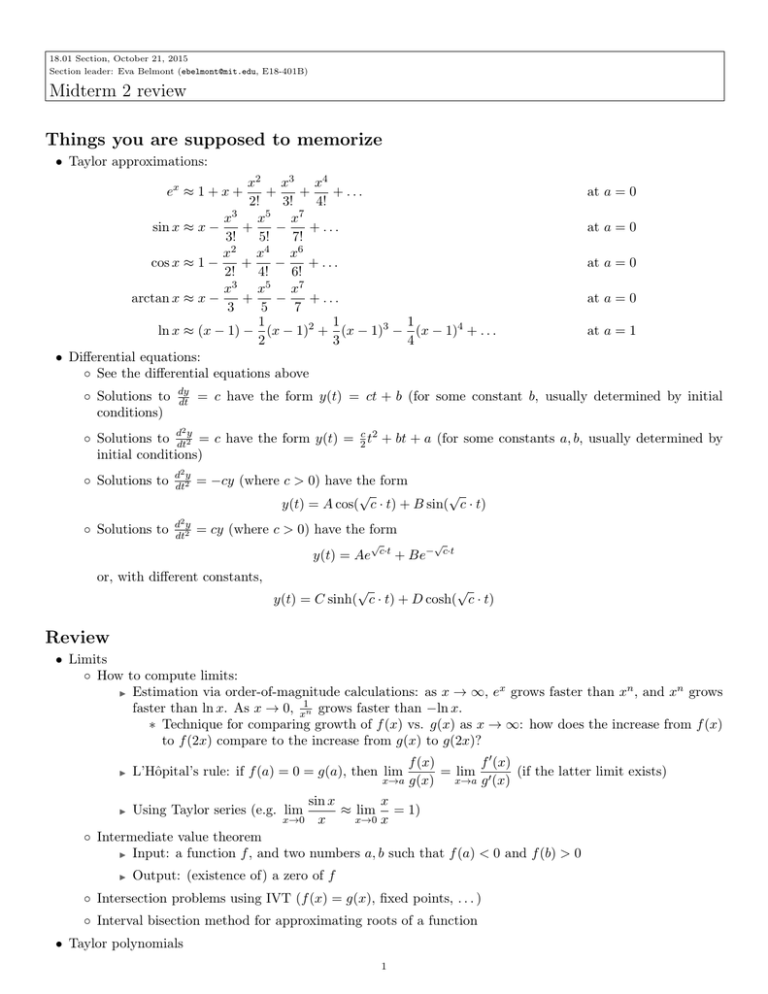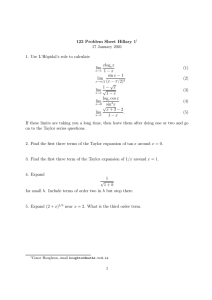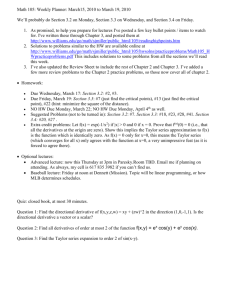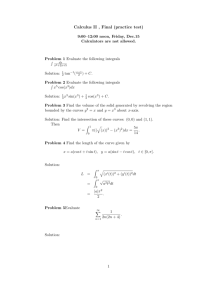Midterm 2 review Things you are supposed to memorize
advertisement

18.01 Section, October 21, 2015 Section leader: Eva Belmont (ebelmont@mit.edu, E18-401B) Midterm 2 review Things you are supposed to memorize • Taylor approximations: x2 x3 x4 + + + ... 2! 3! 4! x3 x5 x7 sin x ≈ x − + − + ... 3! 5! 7! x2 x4 x6 + − + ... cos x ≈ 1 − 2! 4! 6! x3 x5 x7 arctan x ≈ x − + − + ... 3 5 7 1 1 1 ln x ≈ (x − 1) − (x − 1)2 + (x − 1)3 − (x − 1)4 + . . . 2 3 4 • Differential equations: ◦ See the differential equations above ex ≈ 1 + x + ◦ Solutions to conditions) dy dt at a = 0 at a = 0 at a = 0 at a = 0 at a = 1 = c have the form y(t) = ct + b (for some constant b, usually determined by initial 2 ◦ Solutions to ddt2y = c have the form y(t) = 2c t2 + bt + a (for some constants a, b, usually determined by initial conditions) ◦ Solutions to d2 y dt2 ◦ Solutions to d2 y dt2 = −cy (where c > 0) have the form √ √ y(t) = A cos( c · t) + B sin( c · t) = cy (where c > 0) have the form √ y(t) = Ae or, with different constants, c·t √ + Be− c·t √ √ y(t) = C sinh( c · t) + D cosh( c · t) Review • Limits ◦ How to compute limits: x n n I Estimation via order-of-magnitude calculations: as x → ∞, e grows faster than x , and x grows 1 faster than ln x. As x → 0, xn grows faster than −ln x. ∗ Technique for comparing growth of f (x) vs. g(x) as x → ∞: how does the increase from f (x) to f (2x) compare to the increase from g(x) to g(2x)? f (x) f 0 (x) = lim 0 (if the latter limit exists) x→a g(x) x→a g (x) sin x x I Using Taylor series (e.g. lim ≈ lim = 1) x→0 x x→0 x ◦ Intermediate value theorem I Input: a function f , and two numbers a, b such that f (a) < 0 and f (b) > 0 I L’Hôpital’s rule: if f (a) = 0 = g(a), then lim I Output: (existence of) a zero of f ◦ Intersection problems using IVT (f (x) = g(x), fixed points, . . . ) ◦ Interval bisection method for approximating roots of a function • Taylor polynomials 1 ◦ nth order Taylor approximation for f at a is: 1 1 f (x) ≈ f (a) + f 0 (a)(x − a) + f 00 (a)(x − a)2 + · · · + f (n) (a)(x − a)n 2! n! ◦ Know the specific ones above, and know how to use this formula to compute others from scratch ◦ Be on the lookout for situations that require an approximation • Piecewise function problems (e.g. review problem 6 on pset 5) • Differential equations and “physics problems” ◦ See the differential equations above ◦ Look at section 9.6 in the book and go through the worked examples in the text about pendulums and springs. √ √ 2π ◦ Period of y(t) = A cos( c · t) + B sin( c · t) is √ c ◦ Hyperbolic sin and cosine cosh(x) = ex + e−x 2 sinh(x) = d cosh x = sinh x dx ex − e−x 2 d sinh x = cosh x dx • Convexity ◦ Second derivative test f 00 (t) > 0 for t in [a, b] ⇐⇒ f is concave up in [a, b] ⇐⇒ there is at most one critical point in [a, b] and (if it exists) it is a local min f 00 (t) < 0 for t in [a, b] ⇐⇒ f is concave down in [a, b] ⇐⇒ there is at most one critical point in [a, b] and (if it exists) it is a local max ◦ How to remember this? Think about x2 and −x2 . ◦ Should know how to find and classify critical points (use in the region of the critical point to say whether it’s a local min, max, or neither) Problems 1. (a) Use order-of-magnitude estimation to guess the limit lim x→∞ (b) Evaluate lim x→0 2x . ex 2x using L’Hôpital’s rule. −1 ex (c) Evaluate the limit in part (b) using a Taylor approximation. 2 2. Show that cos x has a fixed point. 3. Find the value a (if any) that makes the following function continuous: ( x if x > 0 f (x) = ln(1+x) a if x ≤ 0. 4. Find the cubic p(x) that makes the following function continuous, with continuous derivative: if x < 0 0 f (x) = p(x) if 0 ≤ x < 1 −1 if x > 1. 5. A spring is attached to the wall, and a weight is attached to the other end of the spring. The weight is pulled 0.1 m from the equilibrium position, and then let go. Suppose the period is 2 seconds. What is the weight’s position after 0.25 seconds? 6. Find and classify (using the second derivative test) the critical points of x3 − 3x. 3 Problems to think about at home 1. Use the material on this midterm to come up with as many ways as you can to approximate ln 2 without using a calculator. I can think of at least three: (1) using a Taylor approximation for ln x; (2) using a second-order Taylor approximation for ex ; (3) using a third-order Taylor approximation for ex along with the interval bisection method. 2. (a) Find the polynomial p(x) of minimal degree that makes ( sin(x) if x < 0 f (x) = p(x) if x ≥ 0 continuous, with continuous first derivative. (b) What if you also require the second derivative to be continuous? (c) What if you require all derivatives up to f (k) to be continuous? 3. Using only the Taylor approximations on the “you should memorize this” list, come up with fourth order Taylor approximations for the following: (a) e−x at a = 0 (b) x sin x at a = 0 (c) 1 x2 +1 (d) 1 x+1 at a = 0 at a = 0 4. Approximate √ 3 using interval bisection, to an error of at most 18 . 4








